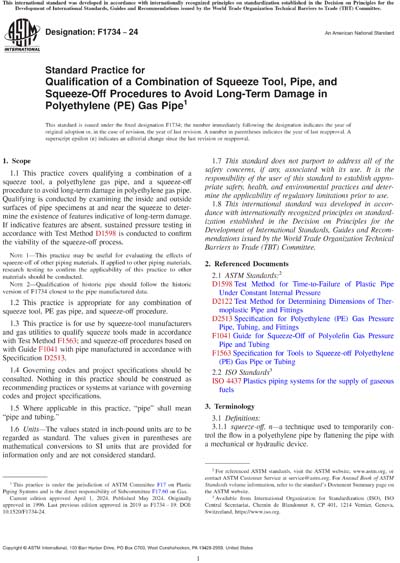Most recent
ASTM F1734-24
Standard Practice for Qualification of a Combination of Squeeze Tool, Pipe, and Squeeze-Off Procedures to Avoid Long-Term Damage in Polyethylene (PE) Gas Pipe
1.1 This practice covers qualifying a combination of a squeeze tool, a polyethylene gas pipe, and a squeeze-off procedure to avoid long-term damage in polyethylene gas pipe. Qualifying is conducted by examining the inside and outside surfaces of pipe specimens at and near the squeeze to determine the existence of features indicative of long-term damage. If indicative features are absent, sustained pressure testing in accordance with Test Method D1598 is conducted to confirm the viability of the squeeze-off process.
Note 1: This practice may be useful for evaluating the effects of squeeze-off of other piping materials. If applied to other piping materials, research testing to confirm the applicability of this practice to other materials should be conducted.
Note 2: Qualification of historic pipe should follow the historic version of F1734 closest to the pipe manufactured data.
1.2 This practice is appropriate for any combination of squeeze tool, PE gas pipe, and squeeze-off procedure.
1.3 This practice is for use by squeeze-tool manufacturers and gas utilities to qualify squeeze tools made in accordance with Test Method F1563; and squeeze-off procedures based on with Guide F1041 with pipe manufactured in accordance with Specification D2513.
1.4 Governing codes and project specifications should be consulted. Nothing in this practice should be construed as recommending practices or systems at variance with governing codes and project specifications.
1.5 Where applicable in this practice, “pipe” shall mean “pipe and tubing.”
1.6 Units—The values stated in inch-pound units are to be regarded as standard. The values given in parentheses are mathematical conversions to SI units that are provided for information only and are not considered standard.
1.7 This standard does not purport to address all of the safety concerns, if any, associated with its use. It is the responsibility of the user of this standard to establish appropriate safety, health, and environmental practices and determine the applicability of regulatory limitations prior to use.
1.8 This international standard was developed in accordance with internationally recognized principles on standardization established in the Decision on Principles for the Development of International Standards, Guides and Recommendations issued by the World Trade Organization Technical Barriers to Trade (TBT) Committee.
ASTM International [astm]

